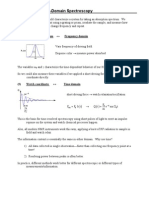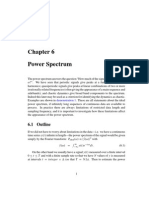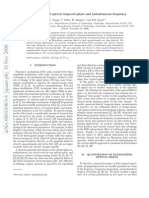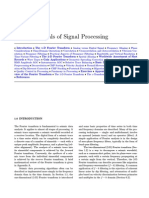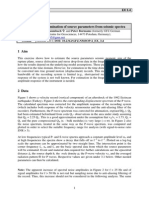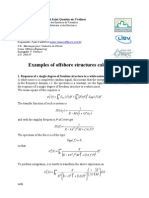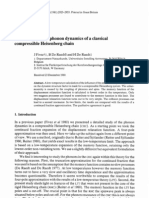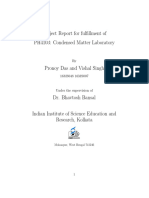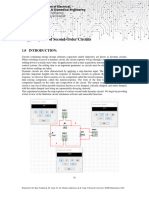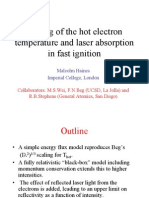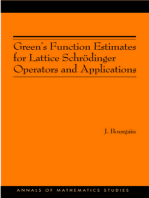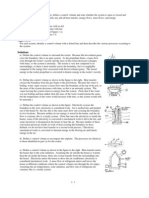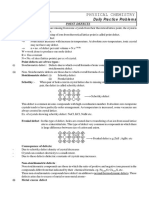Chapter 2: Introduction To Dynamics: Basic Quantities From Earthquake Records
Chapter 2: Introduction To Dynamics: Basic Quantities From Earthquake Records
Uploaded by
Lia AntCopyright:
Available Formats
Chapter 2: Introduction To Dynamics: Basic Quantities From Earthquake Records
Chapter 2: Introduction To Dynamics: Basic Quantities From Earthquake Records
Uploaded by
Lia AntOriginal Title
Copyright
Available Formats
Share this document
Did you find this document useful?
Is this content inappropriate?
Copyright:
Available Formats
Chapter 2: Introduction To Dynamics: Basic Quantities From Earthquake Records
Chapter 2: Introduction To Dynamics: Basic Quantities From Earthquake Records
Uploaded by
Lia AntCopyright:
Available Formats
Richard P.
Ray 1/20
Chapter 2: Introduction to Dynamics
Basic Quantities from Earthquake Records
Earthquakes are complex, dynamic events. In order to describe and work with them, a
vocabulary of terms is necessary. Terms describing the intensity or magnitude of an
earthquake give the engineer a quick estimate of the degree of shaking and damage one
would expect. Other values reflect the time history of the earthquake such as acceleration,
velocity, displacement, power, and other values derived from the time histories.
The size of an earthquake has been reported in several ways. Historically the
earthquake intensity was a qualitative description of the earthquakes ability to cause damage.
The Rossi-Forel (RF) scale describing intensities with values ranging from I to X was
developed in 1880s and used for many years. the modified Mercalli intensity (MMI) scale is
a better way to represent conditions in the U.S. and was adopted there in the 1930s. The
MMI scale is based on performance of familiar structures and is shown in Table 2-1.
Include discussion on Richter, Surface wave, body wave, as well as energy. and Moment
magnitude.
Shown below is a record of earthquake acceleration versus time. Note the irregular shape of
the record. However, one can differentiate portions of strong shaking from portions of weaker
shaking. One can also identify, approximately, the frequency of strong motion in the record.
The maximum acceleration during the event is about 0.32g or 3.1 m/sec
2
at time =17
seconds.
Acceleration vs. Time
-4.0000E-01
-3.0000E-01
-2.0000E-01
-1.0000E-01
0.0000E+00
1.0000E-01
2.0000E-01
3.0000E-01
4.0000E-01
0.00 10.00 20.00 30.00 40.00 50.00 60.00 70.00 80.00 90.00
Time (sec)
A
c
c
e
l
(
g
)
Figure 1. Acceleration vs. Time Record (El Centro, California, 1940)
The record starts with a relatively calm period, mainly due to the arrival of p-waves to
the accelerometer. These waves travel faster than the more-damaging s-waves and r-waves
Richard P. Ray 2/20
and triggered the seismograph. Strong motion starts at about 16 seconds and lasts until about
42 seconds, depending on ones definition of strong motion. Since this is a digital record, we
can study any portion of the record more carefully and calculate several other quantities of
interest to the earthquake engineer. This particular record contains 4187 points, recorded at
time intervals of 0.02 seconds. These records are readily available for downloading at the
United States Geological Survey web site (usgs.gov).
This record has been corrected and adjusted from its original form. One can determine
this by integrating the time series to produce a velocity record that begins and ends at 0.0;
then integrating the velocity to generate a displacement record that begins at 0.0 and ends at
the final coordinates measured after the event (usually 0.0 as well, but there could be
permanent displacements). An uncorrected record would show drift where the velocity and
displacements would not return to zero. Drift is due mainly to the electronic and mechanical
imperfections in the recording device. There are several standard methods for correcting
acceleration records, but we will leave it to the seismologist.
Instead, lets look more closely at the acceleration record between 16 and 20 seconds
as shown in figure 2. The acceleration is indeed irregular, but there are some predominant
frequencies one can make out. Between 16.70 and 17.20 seconds is a large wave; the
corresponding frequency f =2.0 Hz. or = 6.28 radians/sec. One could discover more waves
within the record; however, there are better methods for doing this discussed later.
Acceleration vs. Time, t=16.00 to 20.00 seconds
-4.0000E-01
-3.0000E-01
-2.0000E-01
-1.0000E-01
0.0000E+00
1.0000E-01
2.0000E-01
3.0000E-01
4.0000E-01
16.00 16.50 17.00 17.50 18.00 18.50 19.00 19.50 20.00
Time (sec)
A
c
c
e
l
(
g
)
Figure 2. Accleration vs. Time at t = 16.00 to 20.00 seconds
Note also in figure 2 the actual data points, this is probably a hand-digitized record of an
analog record. More modern equipment can record at faster rates, typically 500-1000 points
every second. Beyond this speed, it becomes a pointless exercise because there is little useful
information to be gained at higher sampling rates; the earthquake motion does not contain
large quantities of very high-frequency signal.
Richard P. Ray 3/20
In order to better quantify the earthquake and a structures response to earthquakes some
simplifying methods are used. Most important in those methods is the concept of harmonic
motion, that is, motion described by
) (
sec) / (
, ,
) sin( ) cos( ) sin(
2
radians lag phase
time t
radians frequency
wave of amplitude A
on accelerati x velocity x nt displaceme x where
t A x t A x t A x
=
=
=
=
= = =
= = =
Equation 2- 1
The phase lag accounts for shifting along the time axis. Typical harmonic motion is shown in
figure 3.
SDOF Response
-1.00E-02
-8.00E-03
-6.00E-03
-4.00E-03
-2.00E-03
0.00E+00
2.00E-03
4.00E-03
6.00E-03
8.00E-03
1.00E-02
0.000 5.000 10.000 15.000 20.000 25.000 30.000 35.000 40.000
time (sec)
D
i
s
p
l
.
(
m
)
Mass =10.132 kg
Damping =0.00
Spring =1.0 N/m
n
=k/m=0.314 r/s
Drive Freq =0.0
Drive Force =0.0 N
Initial Vel. =0.0
m/s
Initial Disp. =0.01 m
Period=1/Frequency
Amplitude
X=A sin(t-)
Figure 3. Single degree of freedom system with initial displacement, no driving function
Amplitude is sometimes called single amplitude since it measures the distance from zero to
maximum (or minimum). Double amplitude would mean from maximum to minimum
values. Frequency, f, and circular frequency, , are related by 2f = . Earthquakes can be
represented as a sum of harmonic motions with different frequencies, amplitudes, and phases.
The frequencies are related to each other as specific multiples, amplitudes and phases and are
calculated via Fourier Transform. This process is very useful in determining the frequency
content of an earthquake, that is, how much low frequency component versus high
frequency component an earthquake contains.
Fourier Transform, Frequency Domain
The Fourier transform is calculated on a discreet time series of acceleration, velocity, or
displacement, such as the earthquake record shown in figure 1. Since the time series and
frequency spectrum are both discreet, the transform is designated DFT or discreet Fourier
transform. Computation of the DFT follows:
Richard P. Ray 4/20
Given a digitized record of acceleration ) (t x with N points at a time interval t, the series
can be decomposed into N/2 +1 harmonics as follows:
t i
N
s
s
S
e X t x
=
=
2 /
0
Re ) (
Equation 2- 2
where
2
,..., 2 , 1 , 0
2 N
s
t N
s
S
=
=
Equation 2- 3
and the
S
X
coefficients are the complex-valued Fourier amplitudes
<
= =
=
=
1
0
1
0
2
1 ,
2
2
, 0 ,
1
N
k
t k i
k
N
k
t k i
k
S
N
s for e
x
N
N
s s for
e x
N
X
S
S
Equation 2- 4
Note that the coefficients are one half the magnitudes at the beginning and end of the series.
The counter, k starts at zero, implying the first coefficient has a frequency = 0.0 associated
with it. In this formula, the time series is regularly spaced according to the formula
1 ,..., 2 , 1 , 0 ), ( = = N k t k x x
k
Equation 2- 5
Eulers identity allows us to compute equation 2-4 as trigonometric functions
) sin( ) cos( t k i t k e
S S
t k i
S
=
Equation 2- 6
From a computer programming aspect, the calculation of coefficients takes place within two
loops; the outer loop increments the value for s and therefore the frequency term. The inner,
faster loop performs the summation over k-values of time series and in most cases the
summation of the real and imaginary parts are kept as separate terms, to be combined later.
The computation of the complex amplitudes
S
X
from the given real values
k
x is most
conveniently made by a fast algorithm known as the Fast Fourier Transform (FFT) by
Cooley and Tukey (1965). This algorithm produces the results of equation 2-4 in a time
proportional to N log (N) as opposed to N
2
by the obvious method. The same algorithm can
produce the inverse transformation from complex amplitudes
S
X
(the frequency domain) to
the real values
k
x (the time domain). A limitation on the use of the fast Fourier transform
method is that N must be a power of 2, (radix 2). This restriction is not important since it is
always possible, and in fact desirable to augment the earthquake by a string of trailing zeros.
The latter is so because the motion given by equation 2-4 is periodic with the period
t N T = Equation 2- 7
Hence, in order to simulate the finite duration of actual earthquakes it is necessary to
introduce a quiet zone at the end of each cycle to allow the viscous damping of the system
time to attenuate the response from one cycle before the beginning of the next cycle.
Since the value of
S
X
is complex, it is often written as a magnitude and phase instead of real
and imaginary components. These terms are interchangeable with the relationship
Richard P. Ray 5/20
2 2
S S S
X X X Mag
+ = Equation 2- 8
and
|
|
.
|
\
|
=
S
S
X
X
1
tan Equation 2- 9
The magnitude is a measure of the content of a given frequency in the earthquake. The phase
is a measure of how the harmonic is positioned along the time axis with respect to the other
harmonics. Fourier spectra are not only useful in earthquake studies, but many other
problems in soil dynamics (machine foundations, railroad, bridge dynamics, and field
measurements) and should become a part of any geotechnical engineers toolkit. Given the
El Centro acceleration record of figure 1, the Fourier Transform is shown below. The record
has been trimmed to 4096 values (in keeping with requirements of FFT to be 2
n
values). It
would have been possible to perform the analysis on 8192 values, but that seems excessive
for this exercise.
Fourier Transform of El Centro Accleration Record
0
0.001
0.002
0.003
0.004
0.005
0.006
0.007
0.008
0 20 40 60 80 100 120
Circular Frequency,
M
a
g
n
i
t
u
d
e
Figure 4 Magnitudes of Fourier Transform; El Centro Acceleration Record
Note that the predominant frequencies are in the range from =7 to 14 r/sec. The higher
frequencies tend to die out simply because there isnt much shaking at those frequencies. The
plot of phase angle would not be very helpful since its values range between /2 and /2 and
there is little pattern to discern any information. This is not true, however for other field
applications where phase is very important (eg. SASW method for determining wave
velocities at a site). Appendix C lists typical computer codes for computation of DFT and
FFT. Also packaged with this module is an Excel spreadsheet for computing DFT.
Richard P. Ray 6/20
The use of harmonics is very important in studying earthquake response of structures. It
forms the basis for many other approaches, including EuroCode methods. There are some
other related calculations necessary for analysis. Elastic and plastic response spectra are two
such computations. They are not the same as FFT, but they are similar. They are discussed in
the next sections.
SDOF systems, Response Spectra
One way to evaluate response of a structure to earthquake motion is to model it as a single-
degree-of-freedom system. This is the most fundamental sort of model one can create for a
structure. Nonetheless, it is very useful to the engineer to evaluate the dynamic response of a
structure to a given earthquake. Before proceeding with earthquake response analysis, it is
necessary to review some concepts of basic vibration and single degree of freedom systems
(SDOF). A SDOF system consists of mass, dashpot, spring, and some driving function.
The differential equation for describing figure 5a is is shown below.
) sin(
0
t P kx x c x m = + + Equation 2- 10
where m =system mass
c =system damping (dashpot)
k =system stiffness (spring constant)
x =displacement
x =velocity
x =acceleration
) sin(
0
t P =driving function, typically a machine
If there is no driving function, the system is a free vibrating system and is driven only by
initial conditions of displacement, or velocity, or both. This is analogous to a pendulum
initially displaced and swinging back and forth. The SDOF equation (2-10) is often re-cast
with the value of damping expressed as a damping ratio (D) where
crit
c c D / = and
km c
crit
= . Typically, damping is much less than critical, perhaps 2%-5% (D=0.02-0.05) of
that value. Most structures are assumed to have this much damping. Foundations may have
more, perhaps 10-25% damping due to the way foundations dissipate energy. Recall that, if
the structure has 0% damping it will shake forever if excited by an earthquake or machine. A
more complete discussion of SDOF systems is given in Appendix A.
m
k/2
c
) sin(
0
t P
k/2
x
m
k/2
c
k/2
x
x
g
x
t
(a)
(b)
Figure 5 Single degree of freedom system SDOF (a) driving function, (b) earthquake
Richard P. Ray 7/20
Earthquake excitation (figure 5b) is nearly the same. There is no forcing function on the
right-hand side as in equation 2-10, but the inertia force, generated by mass and acceleration
is different.
0 = + + kx x c x m
t
Equation 2- 11
where x
t
represents the total displacement of the mass with respect to some reference axis.
This displacement is different from the relative displacement x, seen in the damping and
spring terms. One can rewrite equation 2-11 by splitting x
t
into two components x and x
g
as
seen in figure 4b;
) ( 0 t P x m kx x c x m or kx x c x m x m
earthquake g g
= = + + = + + + Equation 2- 12
The negative sign has little meaning since the earthquake will move in both directions. The
important point is that earthquake forces are generated by the inertial resistance of the
structure. Recall what was said about light structures and structures with less mass near the
top. Since earthquake forces in the building are due to the buildings own mass, less mass
translates to less force.
What is more interesting to the earthquake engineer is how their structure might respond to a
given earthquake. This is evaluated using a method to determine response of a SDOF system
to a general excitation history, such as an earthquake. Duhamels integral is the accepted
method for determining displacement response of a SDOF system to an arbitrary loading
history. A full discussion of Duhamels integral is presented in Appendix B. An elastic
response spectrum is a summary of the maximum displacements of different SDOF structures
to a given earthquake. The structures analyzed have different natural frequencies of shaking
determined by
systems damped D
m
k
systems undamped
m
k
d n
) 1 ( ;
2
= = Equation 2- 13
This can be easily seen by setting mass, m=1.0, damping ratio D=0.0, and k =progressively
larger values to generate higher natural frequencies. A typical response spectrum uses
damping ratios of 0.02 (2%) and 0.05 (5%) as well, to illustrate the effects of structural
damping on response. Remember that an earthquake response spectrum is unique to the
earthquake, not the structure. A displacement response spectrum of the earthquake of figure 1
is shown below (figure 6). Each point on the spectrum represents the maximum displacement
experienced by a SDOF structure with a specified natural frequency and damping ratio,
subjected to the El Centro Earthquake. For example, a structure with a natural frequency of
2.4 rad/sec and 2% damping would experience a maximum horizontal displacement of 4.0
centimeters. This is highlighted on figure 6. Similar spectra can be produced for velocity and
acceleration, either by differentiating the displacement response history or simply scaling
maximum displacements by a factor of for velocity and
2
for acceleration (note the
relationship between amplitudes in equation 2-1). When scaled by the factor , the spectrum
is called pseudo-acceleration, pseudo-velocity or pseudo-displacement.
Response spectra are used in design to represent an envelope of maximum expected
displacements, velocities, and accelerations for design levels of shaking. If a recorded
acceleration record, such as El Centro, is used for design in Gyr, it must be scaled back such
that the maximum levels of shaking fit within the design spectrum limits for Eurocode
design. Methods to do this, and to use design spectra directly, are discussed in later sections.
Richard P. Ray 8/20
Inelastic spectra incorporate an additional property, ductility, into the response equation.
Suppose that the structure in figure 4a,b could also form a plastic hinge in its columns if
deflected far enough. This would drastically reduce the overall stiffness of the structure,
allowing it to absorb more energy (beyond the damping component). Computing an inelastic
response spectrum requires a numerical model with a greater degree of sophistication than the
previous one. Inelastic spectra are discussed in greater detail in Appendix D.
Displacement Response Spectrum
El Centro, 1940 E-W
0.00E+00
1.00E-02
2.00E-02
3.00E-02
4.00E-02
5.00E-02
6.00E-02
7.00E-02
1.00E-01 1.00E+00 1.00E+01 1.00E+02
Frequency (rad/sec)
D
i
s
p
l
a
c
e
m
e
n
t
(
m
)
D=0.0
D=0.02
D=0.05
Figure 6. Displacement Response Spectrum
Response of Multi-Degree of Freedom Systems
One may write separate equations for multi-degree of freedom systems similar to equation 2-
10 for more than one mass, (m
i
), and more than one component of motion (x
i
). The
component of motion could describe a different displacement direction of a point of interest
(node), or could describe the motion of a different node. Similarly, the driving function is
specific to that node or direction, or for earthquake loading, the inertial component is divided
as in equation 12. Examples of multi-degree-of-freedom (MDOF) are shown in figure 7a,b.
The structure in 7a is a stiff-floor, flexible column model as in figure 5. It is allowed to move
in only the horizontal direction and therefore has 3 degrees of freedom (x
1
, x
2
, and x
3
). This
structure will be useful later in the discussion on modal analysis. The beam in 7b may be a
continuous beam and may be analyzed with any number of nodes ( 3). The number and
location of nodes is left to the analyst. He should pick locations of interest (changes in
properties of beam, or where other masses are attached) and at regular intervals to simplify
his own interpretation of results. The number of nodes does not have to be large in order to
obtain a sufficiently accurate model. The degrees of freedom may be vertical as shown
(y
1
y
5
) or vertical and rotational (
1
5
). If both are used, the beam would have 10 degrees
Richard P. Ray 9/20
of freedom and require 10 equations of motion to solve. It should be obvious that one must
resort to matrix methods very soon or be overwhelmed with equations, nodes, and properties.
Formulation of the equations of motion requires some knowledge about how forces
interact in a (somewhat) complex structure. First, the structure is assumed to behave linearly,
so the principle of superposition applies. Second, the stiffness, damping and mass values for
7a are known, for 7b they must be calculated. Both 7a and 7b boundary conditions can be
computed in the same way. If the student is familiar with matrix structural analysis or finite
elements, this process is very similar. If the student is not familiar with these methods, now is
a good time to learn.
In general, four types of forces will be involved at any node: the externally applied load p(t),
and the forces resulting from motion: inertia f
I
, damping f
c
, and spring f
s
. Thus, for each of
the nodes degrees of freedom, dynamic equilibrium may be expressed as:
) (
) (
) (
3 3 3 3
2 2 2 2
1 1 1 1
t p f f f
t p f f f
t p f f f
S D I
S D I
S D I
= + +
= + +
= + +
Equation 2- 14
or when the force vectors are represented in matrix form,
{ } { } { } { } ) (t p f f f
S D I
= + + Equation 2- 15
which is the MDOF equivalent of equation 2-10. Each of the resisting forces is expressed by
means of a set of influence coefficients (spring, damping, mass are no longer sufficient to
describe the structural system since the arrangement of beams, columns etc., has an influence
as well as modulus and moment of inertia of the structural elements). Consider the elastic
(a)
(b)
m
1
k
1
/2
c
1
k
1
/2
x
1
m
2
k
2
/2
c
2
k
2
/2
x
2
k
3
/2
k
3
/2
x
3 m
3
c
3
y
1
y
2 y
4
y
3
y
5
5
Figure 7. 3-Story Stiff Floor System and 10-DOF Beam
Richard P. Ray 10/20
force component developed at point 2 in 7b. It will depend on all the displacements
throughout the structure. Assume for now that we are dealing only with displacements (5
DOF). The elastic component may be written as:
N N S
y k dof more for y k y k y k y k y k f
2 5 25 4 24 3 23 2 22 1 21 2
+ + + + + = Equation 2- 16
for y
3
and y
4
we could write similar equations, more generally,
N iN i i i i i Si
y k dof more for y k y k y k y k y k f + + + + + =
5 5 4 4 3 3 2 2 1 1
Equation 2- 17
The coefficients, k
ij
are called stiffness influence coefficients defined as follows:
j
i
coordinate of nt displaceme unit to due
coordinate to ing correspond force k
ij
=
Equation 2- 18
In matrix form, the complete set of relationships may be written
(
(
(
(
i iN i i
N
N
Si
S
S
y
y
y
k k k
k k k
k k k
f
f
f
2
1
2 1
2 22 21
1 12 11
2
1
Equation 2- 19
in which the matrix of coefficients k
ij
is call the stiffness matrix of the structure (for the
specified set of displacement coordinates) and {y} is the displacement vector representing the
displaced shape of the structure. By analogy with equation 19, damping forces and inertia
forces can be represented by similar matrices of damping influence coefficients and mass
influence coefficients respectively. In each matrix, the coefficients are defined by:
j
i
coordinate of velocity unit to due
coordinate to ing correspond force c
ij
=
Equation 2- 20
j
i
coordinate of on accelerati unit to due
coordinate to ing correspond force m
ij
=
Equation 2- 21
Substituting these matrix expressions into the force equilibrium equation 2-15 yields, in
matrix form
p(t) kx x c x m = + + Equation 2- 22
where each degree of freedom has an equation of motion. It only remains to compute
appropriate values of mass, damping, and stiffness. For the example in figure 7a, we can
displace the first degree of freedom, x
1
one unit, hold the other nodes in place and compute
the forces necessary. and compute the
****scan Kramer pages 575-579 for modal analysis and Cook Malkus Pleshia page 9-11 for
direct stiffness method.
Solution of Undamped System by Modal Analysis
The equation of motion for a MDOF-undamped system is identical to equation 2-22 with the
damping matrix and velocity terms removed:
0 kx x m = + Equation 2- 23
Richard P. Ray 11/20
where 0 is a vector. If one assumes harmonic motion of the system, then for all degrees of
freedom,
) sin( ) ( t t = x x Equation 2- 24
in this equation, x represents the shape of the system (does not change with time, only the
amplitude varies with time) and is the phase angle. Taking the second derivative of
equation 2-24 with respect to time yields acceleration as
x x x
2 2
) sin( ) ( t t = = Equation 2- 25
Substituting equation 2-24 and 2-25 into 2-23 gives
0 x k x = + ) sin( ) sin(
2
t t Equation 2- 26
which can be written by dividing through by the sin() term
| | 0 x m k =
2
Equation 2- 27
Equation 2-27 represents the frequency equation of the system. Mathematically, this is an
eigenvalue problem, with
2
representing N eigenvalues and x representing the N
eigenvectors. The problem can be solved with many modern numerical packages, or by hand
for the first few (lowest) frequencies via Stodola or Holzer methods.
Example 1.
Given the structural system shown in figure 7a, with mass and stiffness values shown,
determine fundamental frequencies:
1
,
2
,
3
and mode shape vectors
1
x
2
x
3
x for the
three degrees of freedom. ***insert example problem here where frequency and mode shapes
are computed as in CP 12-1,12-2***
Dynamic Analysis by Modal Methods
Finally, we are ready to put all this knowledge to use. We want to analyze a system that will
tell us directly the forces transferred to a foundation and structure by an earthquake. Modal
analysis makes use of the concepts discussed earlier.
In the preceding discussion of any arbitrary N-DOF system, the displaced position was
defined by the N components of the displacement vector x. However, for dynamic response
analysis of linear systems, a much more useful representation of the displacements is
provided by the free-vibration mode shapes. These shapes constitute N independent
displacement patterns, the amplitudes of which may serve as generalized coordinates to
express any form of displacement. The mode shapes serve the same purpose as the
trigonometric functions in a Fourier series, and they are advantageous for the same reasons:
because of their orthogonality properties and because they describe the displacements
efficiently so that good approximations can be made with few terms.
Consider, for example, the cantilever column shown in figure 2-83-1, for which the deflected
shape is defined by translational displacement coordinates at three levels.
Any displacement vector x for this structure can be developed by superposing suitable
amplitudes of the three modes of vibration, as shown. For any modal component
n
x the displacements are given by the mode-shape vector
n
multiplied by the modal
amplitude X
n
, thus
Richard P. Ray 12/20
n n n
X x = Equation 2- 28
The total displacement is then obtained as the sum of the modal components,
=
= + + + =
N
n
n n N N 2 2 1 1
X X X X x
1
Equation 2- 29
or, in matrix notation,
X x = Equation 2- 30
Figure 8. Conceptual model of modal analysis
In this equation it is apparent that the mode-shape matrix serves to transform from the
generalized coordinates X to the geometric coordinates x. These mode-amplitude generalized
coordinates are called the normal coordinates of the structure. Because the mode-shape
matrix for a system with N degrees of freedom consists of N independent modal vectors, it
is nonsingular and can be inverted. Thus, it is always possible to solve equation 2-30 directly
for the normal-coordinate amplitudes X associated with any given displacement vector x.
However, the orthogonality property makes it unnecessary to solve any simultaneous
equations in evaluating X. To evaluate any arbitrary normal coordinate X
n
equation 2-30 can
be multiplied by the product of the transpose of the corresponding modal vector and the mass
matrix m
T
n
thus
X m mx
T
n
T
n
= Equation 2- 31
The right-hand side of this equation can be expanded to give
N N 2 1
X X X m m m X m
T
n
T
n
T
n
T
n
+ + + =
2 1
Equation 2- 32
However, all terms of this series vanish except that corresponding to
n
because of the
orthogonality property with respect to mass; thus introducing this one term on the right side
of equation 2-32 gives
n n
X m mx
T
n
T
n
= Equation 2- 33
from which
n
n
X
m
mx
T
n
T
n
= Equation 2- 34
33
x
22
x
32
x
2 2 2
X x =
13
x
23
x
3 3 3
X x =
31
x
21
x
1 1 1
X x =
11
x
12
x
= +
+
x
1
x
2
x
3
X x =
Richard P. Ray 13/20
Of course, each of the normal coordinates X
1
...X
N
is given by an expression of this type. This
process is very similar to the way one derives Fourier coefficients.
Uncoupled Equations Of Motion: Undamped
The orthogonality properties of the normal coordinates now may be used to simplify the
equations of motion of the MDOF system. In general form these equations are given by
equation 2-22; for the undamped system they become
(t) p kx x m = + Equation 2- 35
Introducing equation 2-30 and its second time derivative X x
= (noting that the mode
shapes do not change with time) leads to
) (t p X k X m = +
Equation 2- 36
If equation 2-36 is pre-multiplied by the transpose of the nth mode-shape vector
T
n
, it
becomes
p(t) X k X m
T
n
T
n
T
n
= +
Equation 2- 37
but if the two terms on the left-hand side are expanded as shown in equation 2-32, all terms
except the nth will vanish because of the mode-shape orthogonality properties; hence the
result is
p(t) k m
T
n n
T
n n
T
n
= +
n n
X X
Equation 2- 38
Now new symbols will be defined as follows
) ( ) ( t t P K M
n n n n
p k m
T
n n
T
n
T
n
Equation 2- 39
which are called the normal-coordinate generalized mass, generalized stiffness, and
generalized load for mode n, respectively. With them equation 2-38 can be written
) (t P X K X M
n n n n n
= +
Equation 2- 40
which is a SDOF equation of motion for mode n. If equation 2-27,
n n
m k
2
= , is
multiplied on both sides by
T
n
, the generalized stiffness for mode n is related to the
generalized mass by the frequency of vibration
n n
M K
2
= Equation 2- 41
(Capital letters are used to denote all normal-coordinate properties.) The procedure described
above can be used to obtain an independent SDOF equation for each mode of vibration of the
structure. Thus the use of the normal coordinates serves to transform the equations of motion
from a set of N simultaneous differential equations, which are coupled by the off-diagonal
terms in the mass and stiffness matrices, to a set of N independent normal-coordinate
equations. The dynamic response therefore can be obtained by solving separately for the
response of each normal (modal) coordinate and then superposing these by equation 2-29 to
obtain the response in the original coordinates. This procedure is called the mode-
superposition method
Richard P. Ray 14/20
Uncoupled Equations Of Motion: Damped
Now it is of interest to examine the conditions under which this normal-coordinate
transformation will also serve to uncouple the damped equations of motion. These equations
(equation 2-22) are
p(t) kx x c x m = + + Equation 2- 42
Introducing the normal-coordinate expression of equation 2-30 and its time derivatives and
pre-multiplying by the transpose of the nth mode-shape vector
T
n
leads to
p(t) X k X c X m
T
n
T
n
T
n
T
n
= + +
Equation 2- 43
It was noted above that the orthogonality conditions cause all components except the n
th
mode term in the mass and stiffness expressions of equation 2-37 to vanish. A similar
reduction will apply to the damping expression if it is assumed that the corresponding
orthogonality condition applies to the damping matrix; that is, assume that
n m = 0
n
T
m
c Equation 2- 44
In this case equation 2-40 may be written
) (t P X K X C X M
n n n n n n n
= + +
Equation 2- 45
or alternatively
n
n
n n n n n n
M
t P
X K X X
) (
2 = + +
Equation 2- 46
in which
) ( ) ( 2 t t P K M C M
n n n n n n n n n
p k c m
T
n n
T
n
T
n
T
n
= Equation 2- 47
The normal-coordinate generalized mass, stiffness, and load for the damped system are
identical to those for the undamped system (equation 2-39). The generalized damping for
mode n, which is given by equation 2-47, is of equivalent form. The right-hand term in this
equation constitutes a definition of the nth-mode damping ratio
n
, because the other factors
in the expression are known. As noted earlier, it generally is much more convenient and
physically reasonable to define the damping by the damping ratio for each mode than it is to
try to evaluate the coefficients of the damping matrix c.
Conditions for Damping Orthogonality
In this derivation of the normal-coordinate equations of motion, it has been assumed that the
normal-coordinate transformation serves to uncouple the damping forces in the same way that
it uncouples the inertia and elastic forces. The vibration mode shapes in the damped system
will then be the same as the undamped mode shapes. It is now useful to consider the
conditions under which this uncoupling will occur, that is, the form of damping matrix to
which equation 2-44 applies. Rayleigh showed that a damping matrix of the form
k m c
1 0
a a + = Equation 2- 48
in which a
0
and a
1
are arbitrary proportional factors, will satisfy the orthogonality condition
equation 2-44. This is readily demonstrated by applying orthogonality operation on both sides
Richard P. Ray 15/20
of equation 2-48; thus it is evident that a damping matrix proportional to the mass and/or
stiffness matrices will permit uncoupling the equations of motion. However it was
demonstrated earlier that an infinite number of matrices formed from the mass and stiffness
matrices also satisfy the orthogonality condition. Therefore the damping matrix can also be
made up of the combinations of these. In general, the orthogonal damping matrix may be of
the form
| |
=
b b
b
b
b
a c k m m c
1
Equation 2- 49
in which as many terms may be included as desired. Rayleigh damping (equation 2-48)
obviously is contained in equation 2-49; however, by including additional terms in this
equation it is possible to obtain a greater degree of control over the modal damping ratios
resulting from the damping matrix. With this type of damping matrix it is possible to compute
the damping influence coefficients necessary to provide a decoupled system having any
desired damping ratios in any specified number of modes. For each mode n, the generalized
damping is given by equation 2-47:
n n n n
T
n n
M C 2 = = c Equation 2- 50
But if c is given by equation 2-49, the contribution of term b of the series to the generalized
damping is
n
b T
n b n b
T
n nb
k m m a C c ] [
1
= = Equation 2- 51
Now if equation 2-27 ) (
2
n n n
m k = is pre-multiplied on both sides by
1
km
T
n
, the result
is
n n n
T
n n n
T
n
M k k km
4 2 1
= =
Equation 2- 52
By operations equivalent to this, it can be shown that
| |
n
b
n n
b
T
n
M k m m
2 1
=
Equation 2- 53
and consequently
n
b
n b nb
a C M
2
= Equation 2- 54
On this basis, the damping matrix associated with any mode n is
n n n
b
n
b
n b
b
nb n
M M a C C 2
2
= = =
Equation 2- 55
from which
=
b
b
n b
n
n
a
2
2
1
Equation 2- 56
Equation 2-56 provides the means for evaluating the constants a
b
to give the desired
damping ratios in any specified number of modes. As many terms must be included in the
series as there are specified modal damping ratios; then the constants can be determined from
the resulting set of simultaneous equations. In principle, the values of b can lie anywhere in
the range - <b <, but in practice it is desirable to select values as near to zero as possible.
For example, to evaluate the coefficients to provide for three specified damping ratios, the
equations resulting from equation 2-55 would be
Richard P. Ray 16/20
(
(
(
(
(
(
(
(
(
(
=
(
(
(
1
0
1
3
3
3
3
2
2
3
2
1
1
3
1
3
2
1
1 1
1 1
1 1
2
1
a
a
a
Equation 2- 57
In general, the corresponding relationship may be written symbolically as
Qa
2
1
= Equation 2- 58
where Q is a square matrix involving different powers of the modal frequencies. Equation 2-
58 can then be solved for the coefficients a
1
2
= Q a Equation 2- 59
and finally the damping matrix can be obtained from equation 2-49.
It is of interest to note in equation 2-56 (or 2-57) that when the damping matrix is
proportional to the mass matrix (c =a
0
m; that is, b =0), the damping ratio is inversely
proportional to the frequency of vibration; thus the higher modes of a structure will have very
little damping. Similarly, where the damping is proportional to the stiffness matrix (c =a
1
k;
that is, b =1), the damping ratio is directly proportional to the frequency; and the higher
modes of the structure will be very heavily damped.
A second method is available for evaluating the damping matrix associated with any
given set of modal damping ratios. In principle, the procedure can be explained by
considering the complete diagonal matrix of generalized damping coefficients, which may be
obtained by pre- and post-multiplying the damping matrix by the mode-shape matrix:
(
(
(
(
= =
3 3 3
2 2 2
1 1 1
0 0
0 0
0 0
2
M
M
M
T
c C Equation 2- 60
It is evident from this equation that the damping matrix can be obtained by pre- and post-
multiplying C by the inverse of the mode-shape matrix or its transpose:
| | | | c C = =
1
1
1
1
c
T T T
Equation 2- 61
Thus for any specified set of modal damping ratios
n
, the generalized damping coefficients
C can be evaluated, as indicated in equation 2-60, and then the damping matrix
c evaluated as in equation 2-61.
In practice, however, this is not a very convenient procedure because the inversion of
the mode-shape matrix is a large computational job. Instead, it is useful to take advantage of
the orthogonality properties of the mode shapes relative to the mass matrix. The diagonal
generalized-mass matrix of the system is obtained by pre- and post-multiplying the mass
matrix by the complete mode-shape matrix:
m M
T
= Equation 2- 62
Richard P. Ray 17/20
Pre-multiplying this by the inverse of the generalized-mass matrix then gives
| | m M M M I
1 1 1
= = =
T
Equation 2- 63
from which it is evident that the mode-shape-matrix inverse is
m M
T 1 1
= Equation 2- 64
The damping matrix now is given by substituting equation 2-64 into equation 2-61:
| | | | m M C M m c
T 1 1
= Equation 2- 65
Since c
n
=2
n
n
M
n
, the elements of the diagonal matrix obtained as the product of the three
central diagonal matrices in equation 2-65 are given by
n
n n
n
M
2
Equation 2- 66
and equation 2-65 may be written
m m c
T
= Equation 2- 67
where is the diagonal matrix of elements
n
. In practice it is more convenient to note that each
modal damping ratio provides an independent contribution to the damping matrix, as follows:
m m c
T
n n n
n
= Equation 2- 68
Thus the total damping matrix is obtained as the sum of the modal contributions
m m c c
(
= =
= =
N
n
T
n n
N
n
n
n
1 1
Equation 2- 69
By substituting from equation 2-66 this may be written
m m c
(
=
=
N
n
T
n
n
n n
n
M
1
2
Equation 2- 70
In this equation, the contribution to the damping matrix from each mode is proportional to the
modal damping ratio; thus any undamped mode will contribute nothing to the damping
matrix. In other words, only those modes specifically included in the formation of the
damping matrix will have any damping; all other modes will be undamped.
At this point, it is well to consider under what circumstances it may be desirable to
evaluate the elements of a damping matrix explicitly, as by equation 2-49 or 2-70. It has been
noted that the modal damping ratios are the most effective measures of the damping in the
system when the analysis is to be carried out by the mode-superposition method. Hence the
damping matrix will be needed in explicit form primarily when the dynamic response is to be
obtained by some other analysis procedure, e.g., step-by-step integration of a nonlinear
system.
Damping Coupling
In the foregoing paragraphs, it has been emphasized that where the damping matrix of
the structure is of a form which satisfies the modal orthogonality conditions, the
transformation to the undamped modal coordinates leads to a set of uncoupled equations.
Richard P. Ray 18/20
Since the response of the system can then be obtained by superposing the responses given by
these SDOF equations, this decoupling is a major advantage of the normal coordinates. It was
mentioned earlier, however, that these coordinates have another major advantage which can
be equally important: the essential dynamic response often is associated with the lowest few
modal coordinates, which means that a good approximation to the response can be often
obtained with a drastically reduced number of coordinates.
Where the dynamic response is contained in only a few of the lower modes, it clearly
will be advantageous to apply the normal-coordinate transformation, even with structures for
which the damping matrix does not satisfy the orthogonality condition. In this case, the
generalized damping matrix will not be diagonal; that is, the modal equations will be coupled
by the generalized damping forces. Consequently, the response must be obtained by
integrating these equations simultaneously rather than individually. However, this integration
can be carried out by step-by-step methods, and certainly it is more efficient to perform the
integration for a few coupled normal-coordinate equations than for the original coupled-
equation system.
An alternative procedure would be to solve the complex eigenproblem (which results
when the damping matrix is of general form) and then to obtain an uncoupled set of equations
by transforming to the damped modal coordinates. However, the evaluation of the damped
mode shapes requires much more computation than the undamped eigenproblem solution
does; the problem is of order 2N for a system with N degrees of freedom because a phase
angle must be evaluated for each degree of freedom as well as its relative amplitude. For this
reason the use of the undamped mode shapes generally is more efficient. The complex
eigenproblem is discussed in more detail under Methods of complex response.
SUMMARY OF THE MODE-SUPERPOSITION PROCEDURE
The normal-coordinate transformation, which serves to change the set of N coupled equations
of motion of a MDOF system into a set of N uncoupled equations, is the basis of the mode-
superposition method of dynamic analysis. This method can be used to evaluate the dynamic
response of any linear structure for which the displacements have been expressed in terms of
a set of N discrete coordinates and where the damping can be expressed by modal damping
ratios. The procedure consists of the following steps.
1. Equations Of Motion For this class of system, the equations of motion may be
expressed [Eqs. (10-13)] as
) (t p kx x c x m = + +
2. Mode Shape And Frequency Analysis For undamped, free vibrations, this matrix
equation can be reduced to the eigenvalue equation [Eq. (12-4)]:
| | 0 x m k =
2
from which the vibration mode-shape matrix and frequency vector can be
determined.
3. Generalized Mass And Load. With each mode-shape vector
n
being used in turn,
the generalized mass and generalized load for each mode can be computed.
) (t P M
T
n n n
T
n n
p m = =
4. Uncoupled Equations Of Motion The equation of motion for each mode can then
be written, using the generalized mass and force for the mode together with the
modal frequency
n
and a specified value of the modal damping ratio
n
as follows
Richard P. Ray 19/20
n
n
n n n n n n
M
t P
Y Y Y
) (
2
2
= + +
5. Modal Response To Loading The result of step 4 is a set of N independent
equations of motion, one for each mode of vibration. These SDOF equations can be
solved by any suitable method, depending on the type of loading. The general
response expression given by the Duhamel integral [Eq. (7-14)] for each mode is
( ) d t
t
n
e P
M
t Y
t
Dn n
Dn n
n
=
|
.
|
\
|
0
sin ) (
1
) (
6. Modal Free Vibrations. Equation (7-14) is applicable for a system which is at rest
at time t =0. If the initial velocity and displacement are not zero, a free vibration
response must be added to the Duhamel integral expression for each mode. The
general damped free-vibration response is given [Eq. (3-26)] for each mode by
(
+
+
= t Y t
Y Y
t
e t Y
Dn n Dn
Dn
n n n n
n n
n
cos ) 0 ( sin
) 0 ( ) 0 (
) (
where Y
n
(0) and ) 0 (
n
Y
represent the initial modal displacement and velocity. These
can be obtained from the specified initial displacement x(0) and velocity
) 0 ( x expressed in the original geometric coordinates as follows for each modal
component [Eq. )(13-5)] :
n
T
n
n
M
Y
) 0 (
) 0 (
mx
=
n
T
n
n
M
Y
) 0 (
) 0 (
x m
=
7. Displacement Response In Geometric Coordinates. When the response for each
mode Y
n
(t) has been determined from Eq.(2-14) and/or Eq. (2-26), the displacements
expressed in geometric coordinates are given by the normal-coordinate
transformation, Eq. (13-2): ) ( ) ( t t Y x =
Equation (13-2) may also be written
+ + + = ) ( ) ( ) ( ) (
3 3 2 2 1 1
t Y t Y t Y t x
that is, it merely represents the superposition of the various modal contributions;
hence the name mode-superposition method. It should be noted that for most types of
loadings the contributions of the various modes generally are greatest for the lowest
frequencies and tend to decrease for the higher frequencies. Consequently, it usually
is not necessary to include all the higher modes of vibration in the superposition
process [Eq. (13-2)]; the series can be truncated when the response has been obtained
to any desired degree of accuracy. Moreover, it should be kept in mind that the
mathematical idealization of any complex structural system also tends to be less
reliable in predicting the higher modes of vibration; for this reason, too, it is well to
limit the number of modes considered in a dynamic-response analysis.
8. Elastic Force Response. The displacement history of the structure may be
considered to be the basic measure of its response to dynamic loading. In general,
other response parameters such as stresses or forces developed in various structural
components can be evaluated directly from the displacements. For example, the
elastic forces f
s
which resist the deformation of the structure are given directly [Eq.
(10-6)] by ) ( ) ( ) ( t t t
s
Y k kx f = =
Richard P. Ray 20/20
An alternative expression for the elastic forces may be useful in cases where the
frequencies and mode shapes have been determined from the flexibility form of the
eigenvalue equation [Eq. (12-17)]. Writing Eq. (13-43) in terms of the modal
contributions + + + = ) ( ) ( ) ( ) (
3 3 2 2 1 1
t Y t Y t Y t
s
k k k f
and substituting Eq. (12-39) leads to
+ + + = ) ( ) ( ) ( ) (
3 3
2
3 2 2
2
2 1 1
2
1
t Y t Y t Y t
s
m m m f
Writing the series in matrix form gives
| | ) ( ) (
2
t Y t
n n s
m f =
where | | ) (
2
t Y
n n
represents a vector of modal amplitudes each multiplied by the
square of its modal frequency. In Eq. (13-44) the elastic force associated with each
modal component has been replaced by an equivalent modal inertia-force
expression. The equivalence of these expressions was demonstrated from the
equations of free-vibration equilibrium [Eq. (13-29)]; however, it should be noted
that this substitution is valid at any time, even for a static analysis. Because each
modal contribution is multiplied by the square of the modal frequency in Eq. (13-
44), it is evident that the higher modes are of greater significance in defining the
forces in the structure than they are in the displacements. Consequently, it will be
necessary to include more modal components to define the forces to any desired
degree of accuracy than to define the displacements.
Method of complex response
It has become common practice with newer, more efficient computer codes to analyze
a damped system via method of complex response. As mentioned earlier, the computational
effort is greater since one must tract a complex value (two values) instead of a real value (on
value). However, much of the economies of calculation discussed earlier still apply. This
method is employed in a variety of well-known codes such as LUSH, FLUSH, SASSI, and
others. The main idea is to exploit the use of super-position and harmonic representation of
earthquake shaking.
You might also like
- Drakhlis Boris - Calculate Oscillator Jitter by Using Phase-Noise Analysis Part 1Document6 pagesDrakhlis Boris - Calculate Oscillator Jitter by Using Phase-Noise Analysis Part 1beppes66100% (1)
- Split Operator MethodDocument13 pagesSplit Operator MethodLucian S. VélezNo ratings yet
- Chapter 2: Introduction To Dynamics: Basic Quantities From Earthquake RecordsDocument20 pagesChapter 2: Introduction To Dynamics: Basic Quantities From Earthquake RecordspotpotvolksNo ratings yet
- Time Vs FreqDocument8 pagesTime Vs FreqSanjiv Kumar Deepesh MishraNo ratings yet
- Husky EnergyDocument15 pagesHusky EnergyEzzadin BabanNo ratings yet
- Spectral Correlation Measurement PDFDocument12 pagesSpectral Correlation Measurement PDFSabri KhalidNo ratings yet
- ReportDocument41 pagesReportCassella AdrianoNo ratings yet
- Lecture03 Ultrashort Pulses 01Document33 pagesLecture03 Ultrashort Pulses 01Yeong Gyu KimNo ratings yet
- Linear AccelerationDocument6 pagesLinear AccelerationNiyat PatelNo ratings yet
- Kuliah-5 Response Spectrum + Zona GempaDocument92 pagesKuliah-5 Response Spectrum + Zona GempaJimmy DonNo ratings yet
- Power Spectrum: 6.1 OutlineDocument7 pagesPower Spectrum: 6.1 Outlinemananshafqat1035No ratings yet
- Wave Optics Part IDocument62 pagesWave Optics Part IAt TanwiNo ratings yet
- Quantum Theory of Optical Temporal Phase and Instantaneous FrequencyDocument16 pagesQuantum Theory of Optical Temporal Phase and Instantaneous FrequencyNiranjan SridharNo ratings yet
- Frequency Domain ProcessingDocument42 pagesFrequency Domain ProcessingInJune YeoNo ratings yet
- Prof. A. Meher Prasad: Department of Civil Engineering Indian Institute of Technology MadrasDocument101 pagesProf. A. Meher Prasad: Department of Civil Engineering Indian Institute of Technology MadrasEsteban Gabriel Misahuamán CórdovaNo ratings yet
- Laboratory 3: The LCR Circuit: Forced, Damped Oscillations.: Phys130 Fall, 2003Document5 pagesLaboratory 3: The LCR Circuit: Forced, Damped Oscillations.: Phys130 Fall, 2003Virali DoshiNo ratings yet
- 5 Seismometry Earthquake Location EqMagnitude Tsunami EqPredictionDocument62 pages5 Seismometry Earthquake Location EqMagnitude Tsunami EqPredictionkaranbatra874No ratings yet
- Sdan 0025-0158 CDocument134 pagesSdan 0025-0158 CGis7No ratings yet
- On The Fundamental Aspects of DemodulationDocument11 pagesOn The Fundamental Aspects of DemodulationAI Coordinator - CSC JournalsNo ratings yet
- Pierson Moskowitz Sea SpectrumDocument45 pagesPierson Moskowitz Sea Spectrumsf232340% (1)
- Topic Determination of Source Parameters From Seismic SpectraDocument7 pagesTopic Determination of Source Parameters From Seismic SpectraFrancisco JavierNo ratings yet
- Matlab - Generating Sine and Cosine WavesDocument8 pagesMatlab - Generating Sine and Cosine WaveslentelsoupNo ratings yet
- Assignment Sheet 1 Mechanical Measurements and Instrumentation Due Date On or Before 16/09/2014 Problems Based On Chap 3 - DynamiccharactersticsDocument3 pagesAssignment Sheet 1 Mechanical Measurements and Instrumentation Due Date On or Before 16/09/2014 Problems Based On Chap 3 - DynamiccharactersticsJim HarrisNo ratings yet
- Exemple of Offshore Structures CalculationDocument25 pagesExemple of Offshore Structures Calculationwlueji100% (1)
- J Fivez, B de Raedt and H de Raedt - Low-Temperature Phonon Dynamics of A Classical Compressible Heisenberg ChainDocument11 pagesJ Fivez, B de Raedt and H de Raedt - Low-Temperature Phonon Dynamics of A Classical Compressible Heisenberg ChainTellusz4532No ratings yet
- Time Domain Transient Analysis of Electromagnetic Field Radiation For Phased Periodic Array Antennas ApplicationsDocument4 pagesTime Domain Transient Analysis of Electromagnetic Field Radiation For Phased Periodic Array Antennas Applicationspetrishia7_317164251No ratings yet
- A: Dispersive and Nondispersive WavesDocument10 pagesA: Dispersive and Nondispersive WavesKyungHwan OhNo ratings yet
- 2 Seismic Analysis of Single Degree of Freedom SystemsDocument13 pages2 Seismic Analysis of Single Degree of Freedom SystemsLargu George DanielNo ratings yet
- Lect 10Document9 pagesLect 10अमरेश झाNo ratings yet
- Experiment 2: Uniformly Accelerated MotionDocument5 pagesExperiment 2: Uniformly Accelerated MotionAustin TutorNo ratings yet
- Chapter 3. The Lorentz System - Paul TobinDocument55 pagesChapter 3. The Lorentz System - Paul TobinN DNo ratings yet
- Control SystemDocument16 pagesControl Systemvishnuraju2003No ratings yet
- Density Operator of A Two-Level System - Electric Dipole InteractionDocument22 pagesDensity Operator of A Two-Level System - Electric Dipole Interactionlahoual70No ratings yet
- PH4103: Condensed Matter LaboratoryDocument23 pagesPH4103: Condensed Matter LaboratoryVishal SinghNo ratings yet
- Notes On Fourier Transforms: PHYS 332: Junior Physics Laboratory IIDocument6 pagesNotes On Fourier Transforms: PHYS 332: Junior Physics Laboratory IIFayazKhanPathanNo ratings yet
- Response Spectrum For Dynamic Effect of Ground MotionsDocument29 pagesResponse Spectrum For Dynamic Effect of Ground MotionsMohammed Junaid ShaikhNo ratings yet
- Chapter 3Document22 pagesChapter 3Pedro MiguelNo ratings yet
- An Experimental Verification of Newtons Second LaDocument5 pagesAn Experimental Verification of Newtons Second LaThythin PororoNo ratings yet
- Mansard Funke 1980Document19 pagesMansard Funke 1980AzisNo ratings yet
- ELE302 - Lab 2-092021Document17 pagesELE302 - Lab 2-092021hughjass39.99No ratings yet
- Est Fin 2014solDocument2 pagesEst Fin 2014solKarn KumarNo ratings yet
- Response of Structures To Impulsive Loads: Abstract: Impulsive Force Is A Force of Large Magnitude That Acts Over ADocument4 pagesResponse of Structures To Impulsive Loads: Abstract: Impulsive Force Is A Force of Large Magnitude That Acts Over ADhurai KesavanNo ratings yet
- Ch6 PDFDocument34 pagesCh6 PDFVennela VasupilliNo ratings yet
- Very Clear 2 - Bremsstrahlung PDFDocument19 pagesVery Clear 2 - Bremsstrahlung PDFhammoudeh13No ratings yet
- Scaling of The Hot Electron Temperature and Laser Absorption in Fast IgnitionDocument20 pagesScaling of The Hot Electron Temperature and Laser Absorption in Fast IgnitionKevin M GeorgeNo ratings yet
- Sinusoids: Tamara Smyth, Tamaras@cs - Sfu.ca School of Computing Science, Simon Fraser University January 16, 2006Document4 pagesSinusoids: Tamara Smyth, Tamaras@cs - Sfu.ca School of Computing Science, Simon Fraser University January 16, 2006Ifan AzizNo ratings yet
- Whitepaper Ncode Frequency Domain Fatigue-Halfpenny PDFDocument9 pagesWhitepaper Ncode Frequency Domain Fatigue-Halfpenny PDFTaleb AlrayyesNo ratings yet
- Time-Series Analysis PDFDocument53 pagesTime-Series Analysis PDFFabian Andres Perdomo LagunaNo ratings yet
- Response Spectrum AnalysisDocument52 pagesResponse Spectrum AnalysisanmoljassalNo ratings yet
- Molecular Dynamics Simulations: Che 520 Fall 2009Document8 pagesMolecular Dynamics Simulations: Che 520 Fall 2009Fabio OkamotoNo ratings yet
- Nicholson Ross Extraction MethodDocument6 pagesNicholson Ross Extraction MethodTom SebastianNo ratings yet
- A Finite - Fault Modeling of The 1755 Lisbon Earthquake SourcesDocument22 pagesA Finite - Fault Modeling of The 1755 Lisbon Earthquake SourcesRajaram ChennaNo ratings yet
- Uyuybjyug PDFDocument22 pagesUyuybjyug PDFRajaram ChennaNo ratings yet
- Student Solutions Manual to Accompany Economic Dynamics in Discrete Time, second editionFrom EverandStudent Solutions Manual to Accompany Economic Dynamics in Discrete Time, second editionRating: 4.5 out of 5 stars4.5/5 (2)
- Feynman Lectures Simplified 2C: Electromagnetism: in Relativity & in Dense MatterFrom EverandFeynman Lectures Simplified 2C: Electromagnetism: in Relativity & in Dense MatterNo ratings yet
- Green's Function Estimates for Lattice Schrödinger Operators and ApplicationsFrom EverandGreen's Function Estimates for Lattice Schrödinger Operators and ApplicationsNo ratings yet
- Cooling Tower - WikipediaDocument21 pagesCooling Tower - WikipediaKiran KotinNo ratings yet
- Mechanical Properties of FluidsDocument20 pagesMechanical Properties of FluidsTrillionare HackNo ratings yet
- CH 1Document14 pagesCH 1Grant ThorneNo ratings yet
- Chiller - Air - Oil SV TechnologiesDocument4 pagesChiller - Air - Oil SV TechnologiesSV TechnologiesNo ratings yet
- Concrete Filled Tubular StructureDocument9 pagesConcrete Filled Tubular Structureashish SindhuNo ratings yet
- CIVE - 370 Joe IssaDocument6 pagesCIVE - 370 Joe Issajoeissa523No ratings yet
- Ballistic Testing of SSAB Ultra-High Hardness Steel For Armor ApplicationsDocument9 pagesBallistic Testing of SSAB Ultra-High Hardness Steel For Armor ApplicationsMarwan JBNo ratings yet
- Simple MachinesDocument11 pagesSimple Machinestipen pakombongNo ratings yet
- Point Defects (13th)Document2 pagesPoint Defects (13th)Raju SinghNo ratings yet
- Cryogel Z Technical Guide 2.0Document58 pagesCryogel Z Technical Guide 2.0dodi ikhsanNo ratings yet
- Heise 1948Document7 pagesHeise 1948George AcostaNo ratings yet
- Priestey Et Al 2007 Diseño Por DesplazamientosDocument12 pagesPriestey Et Al 2007 Diseño Por DesplazamientosUlises MendozaNo ratings yet
- Hansen Solubility ParameterDocument24 pagesHansen Solubility ParametersdrtfgNo ratings yet
- Project Proposal On Design and Modelling and Development Of: Submission DateDocument24 pagesProject Proposal On Design and Modelling and Development Of: Submission DatemuseNo ratings yet
- Contributors: PERRY'S CHEMICAL ENGINEER'S HANDBOOKDocument8 pagesContributors: PERRY'S CHEMICAL ENGINEER'S HANDBOOKAnonim PlayerNo ratings yet
- 1995 Chem Eng JHogendoornDocument11 pages1995 Chem Eng JHogendoornАлексей МинькоNo ratings yet
- Bearing Capacity Effect of Soft Clay With Sand Compaction PilesDocument4 pagesBearing Capacity Effect of Soft Clay With Sand Compaction PilesrambabuNo ratings yet
- De Super HeaterDocument12 pagesDe Super HeaternewprocessNo ratings yet
- Basics of Gray Iron Casting DesignDocument9 pagesBasics of Gray Iron Casting DesignVarga TrigustaraNo ratings yet
- Colligative Property of SolutionDocument9 pagesColligative Property of SolutionissaiahnicolleNo ratings yet
- TM-AFCU (Iii) PDFDocument121 pagesTM-AFCU (Iii) PDFZacke EsmaNo ratings yet
- Shotcrete Support Load CalculationsDocument6 pagesShotcrete Support Load Calculationsanon_160157252No ratings yet
- De 6 Sem Report Designing 02Document19 pagesDe 6 Sem Report Designing 02manish318No ratings yet
- A. DBR For Cooling Tower, Rev.0Document2 pagesA. DBR For Cooling Tower, Rev.0SumitBhaumikNo ratings yet
- Tabla Uw-12Document1 pageTabla Uw-12Christian Lopez Mendez100% (1)
- MicromanufacturingDocument20 pagesMicromanufacturingVishwajeet GuptaNo ratings yet
- Continuous Scrap Melting in A Short Rotary FurnaceDocument12 pagesContinuous Scrap Melting in A Short Rotary FurnaceAnonymous ipcYV390% (1)
- Hi-Tech Bush SpecsDocument4 pagesHi-Tech Bush SpecsRony MartínezNo ratings yet
- Description Applications: Tipplen K 850 Impact Copolymer For Extrusion ApplicationsDocument4 pagesDescription Applications: Tipplen K 850 Impact Copolymer For Extrusion ApplicationsRuberlei FerrerNo ratings yet
- Softex CouplingsDocument20 pagesSoftex Couplingswen.cokNo ratings yet



